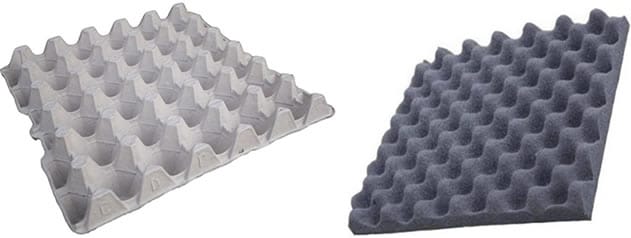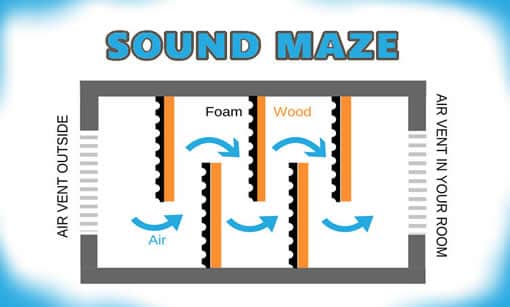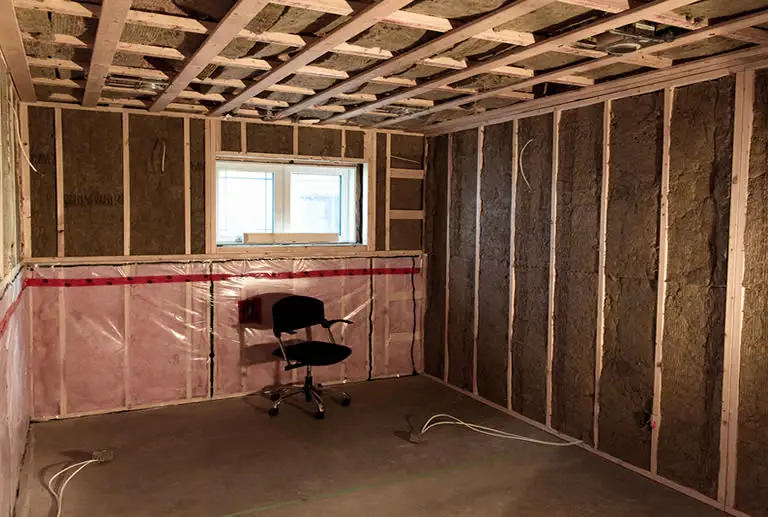Although a man cave is a great place to kick-back with your buddies with a few beers, a few beers often leads to a few more and before you know it things are getting a little loud. When you want to have the freedom of loud music, or loud friends, but don’t want to annoy family members or complaining neighbors then you should consider soundproofing your man cave.
be aware that the information below works equally well to soundproof a shed, whether that be a man cave shed or a she shed.
Contents
How To Soundproof A Man Cave The Easy Way
Use weather-strip tape to seal the door frame and the window frames. You may need to add additional soundproofing to the door and the window.
Find and plug all the noise holes.
If you have structural sound leaks you will need to take additional action to soundproof the walls.
Busting the myth of using egg cartons for soundproofing
I remember in my teenage years, when I played in a rock band, almost every practice place that was set-up by musicians was “soundproofed” with egg cartons. Of course it didn’t work. You could often hear screaming vocals and guitar licks a few blocks away (some more musical than others).
Egg cartons are simply not an effective soundproofing material. They have been specifically designed to cushion fragile eggs against impacts and they are good at doing that. They are not good at blocking sound.
Although egg cartons may resemble egg crate foam in appearance, that’s where the similarity ends.
Egg crate foam has been scientifically formulated to block sound and most of that sound blocking is done by the material it is constructed from not the design (though the design does play a part).
Egg crate soundproofing foam works great to block noise if it is placed in strategic places such as behind a drywall or pinned to the door etc.
Egg cartons will not have the same effect.

Sound blocking vs. sound dampening
Sometimes no matter what you do you just cannot eliminate all the sound coming from your man cave.
This is because it is easier to build a soundproof structure than it is to soundproof an existing structure.
However, if you follow the steps outlined above you should be able to at least dampen the sound enough that it does not cause distress to others outside the cave.
The 2 types of sound insulation for a man cave
There are two types of soundproofing projects that are usually undertaken.
These are:
- Blocking sound from entering a room or building.
- Stopping sound from escaping from a room or building.
1. Blocking sound from entering the man cave
Sound insulation against the outside is not needed as much as the second type of soundproofing but is sometimes necessary if you live in an especially noisy neighborhood or you want almost complete silence in your man cave.
If you are creating a man cave for peace and quiet, as a refuge from daily life, then you will likely want to block noise from entering your den.
Outside noise can spoil the atmosphere in a man cave, especially if it is your quiet space.
Preventing outside noise from entering a man cave usually requires a different approach to soundproofing that the approach used to keep noise inside the man cave (a much more common use of soundproofing in man caves).
However, all forms of soundproofing will, to some degree, stop noise from escaping and prevent noise from entering.
2. Stopping sound from escaping from the man cave
Internal sound insulation for a man is the most common reason for soundproofing your den.
Unless you have built your man cave in a very noisy area you will want to undertake the second project – insulating your man cave so no noise escapes from it. This way you won’t need to worry about getting too loud or rowdy.
It is possible to completely soundproof your man cave for a just a few hundred bucks with the right items and a hands-on, do-it-yourself approach.
5 Easy steps to soundproofing a man cave
You will want to block the sound coming from your man cave as much as possible.
This means you may need to soundproof the walls if they are not solid enough to block incoming and outgoing sounds (more on that later) but you will also need to ensure the door and windows are also soundproofed.
Door and windows are often overlooked when soundproofing a room and are one of the biggest causes of sound leaks. We will therefore start with these.
1. Items you will need before you begin
You will need the following items before you begin your man cave soundproofing project:
- Soundproof foam.
- Simple weather strip tape.
- Construction knife with retractable blade (or similar).
Optional:
2. Soundproof the door and door frame as noise escapes from here the most
Believe it or not the vast majority of sound that escapes from a room gets out through a closed door.
The gaps between the door and the door frame allows sound to easily escape from your man cave. It is easily fixed though.
For most projects soundproofing the area between the door and the door frame will be enough to block sound from escaping. What’s more, soundproofing a door is fairly easy and inexpensive to do.
Simple weather-strip tape, like this stuff, can be used to plug these sound leaks. Doing this has the added advantage of making the door wind resistant and waterproof as well if it is part of a backyard man cave.
The idea is to form a solid mass of foam between the door and door frame that sound has difficulty passing through – when the door is shut it compresses against the foam weather-strip to form this impassable solid mass.
It is easy to install weather-strip tape as you can see from the video below. If you want to ensure your door is comprehensively soundproofed consider using these type of door gaskets that are more expensive but provide better soundproofing and weatherproofing.
You may need to take further action if your door is hollow. You will know if the door is hollow or solid wood by its weight or by knocking your knuckles against it. If knocking the door produces a dull sound then the door is most likely solid. Most doors inside your home will likely be hollow while doors leading to the outside tend to be solid..
One way to soundproof the door is to cover it with a soundproof blanket or with soundproof foam
although foam is somewhat unsightly and can be costly.
A cheaper, and better looking, alternative is to nail a thick piece of wood to the door to help block noise escaping. You can use tempered hardboard or something a bit more rustic and then varnish or paint it.
Don’t forget to add a cheap door sweep to the bottom of the door as this will also help with soundproofing while stopping chilly winds getting in as well.
3. Soundproof the windows to seal those noise leaks
By far the most effective way to soundproof a window is to completely block it. This can be done through noise reducing curtains.
Arguably, the best way to help soundproof a window though is to use specially designed acoustic curtains though these can be expensive. For the most part noise reducing curtains should do the job.
However, just like you did with the door frame you will also need to soundproof the window frame if you want to avoid sound leaks.
The best way to do this is to uses insulation tape. Although this is designed to help weatherize the window it will greatly help with soundproofing and prevent most of the noise from escaping.
Of course if you have the budget you can replace the existing windows with soundproof windows.
4. Sound proof vents as an extra noise reduction step
Completely sealing off air vents is not really a good idea as they are there for a reason. Air vents allow fresh air to get into the room and stale air to leave. They also help regulate the temperature.
If you completely seal an air vent your man cave will soon feel stuffy and the more people you have in there the hotter it will get as body heat generates the same heat as a 100 watt light bulb.
A much better alternative to blocking the vent is to put a cover on it that opens and closes so you can open it during the day to “air” the man cave and close it when things start to get a little rowdy.
Alternatively you can place strips of soundproofing foam, that are attached to strips of wood for support, at strategic locations throughout the vent. It’s easier to do this than it is to explain how to do it but here goes.
Simply cut a few pieces of soundproofing foam to the full height of the vent but only half the width. Place one piece at the front of the vent, just inside to the left, and then close behind place another piece to right.
Just glue and/or screw these into place.
Continue this staggered approach until you run out of room.
This will allow fresh air to access the room but will greatly dampen both noise getting in and noise getting out.

5. Structural sound leaks through the walls need to be addressed also
Depending on the construction material used for your man cave you may have to deal with sound passing through the walls.
If you have a brick building then you will be unlikely to encounter a problem with sound leakage through the walls as brick naturally blocks noise.
Contrary to popular belief most sound does not pass through the walls.
Likewise, if your man cave is built from sturdy solid wood you are also less likely to encounter this problem.
However, if your man cave is situated in a shed with thin walls that have no drywall or insulation then noise will probably leak out.
The only way to really know if you have to deal with this type of sound leakage is to complete the soundproofing jobs mentioned above and then see if any sound is still escaping when you stand outside the man cave.
If you need to deal with these sound leaks you will have to remove the existing drywall, and then add soundproofing foam before replacing it, or put up a second layer of drywall with soundproofing foam.

